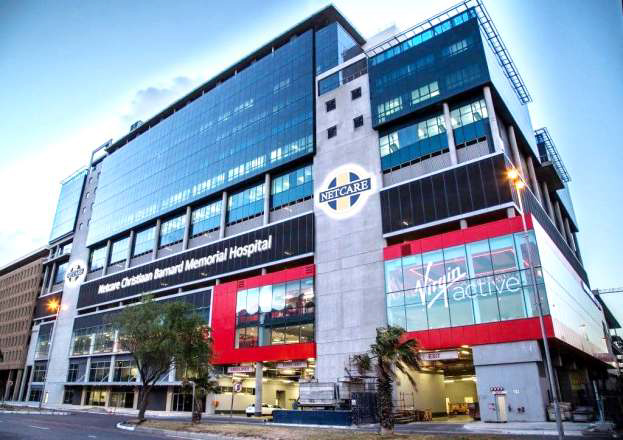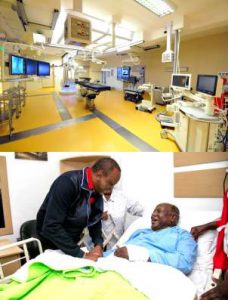The African medical devices market is growing with a steady pace; mainly due to the rapidly growing middle income group, increasing healthcare expenditure, growing number of medical tourists, proliferation of hospitals and supporting government programs.
Africa is the world’s second largest and second most-populous continent behind Asia in both categories. At about 30.3 million sq km (11.7 million sq miles) including adjacent islands, this continent covers around 6 per cent of the earth’s total surface area and 20 per cent of its land area. With 1.2 billion people as of 2016, it accounts for about 16 per cent of the world’s human population.
 Africa’s average population is the youngest amongst all the continents; the median age in 2012 was 19.7, when the worldwide median age was 30.4. Algeria is Africa’s largest country by area, and Nigeria is its largest by population . Africa straddles the equator and encompasses numerous climate areas; it is the only continent to stretch from the northern temperate to southern temperate zones.
Africa’s average population is the youngest amongst all the continents; the median age in 2012 was 19.7, when the worldwide median age was 30.4. Algeria is Africa’s largest country by area, and Nigeria is its largest by population . Africa straddles the equator and encompasses numerous climate areas; it is the only continent to stretch from the northern temperate to southern temperate zones.
Healthcare in Africa
continent of over one billion people and South Africa is expected to account for US$34.1 billion, equal to 29.1 per cent of the total for healthcare for the population. South Africa spends around US$700 per person, while many countries considered less developed, spend less than US$50 per person.
In South Africa, despite efforts to transform the health system into an integrated, comprehensive national health system, and significant investment and expenditure, the health sector has largely been beset by key challenges inclusive of a complex, quadruple burden of diseases; serious concerns about the quality of public healthcare; an ineffective and inefficient health system; and spiraling private healthcare costs. The government GDP for healthcare is 8.7 per cent of GDP (latest statistic 2013).
Overall, the healthcare sector in sub-Saharan Africa continues to show signs of remarkable growth. The quality of hospitals and the availability of qualified doctors have dramatically improved over the last few years in much of the continent, although this growth is uneven. By making the transformation from traditional medicine to a modern and well-structured healthcare system, many African countries have been able to meet the growing demands for quality healthcare services for their people.
Import-dependent medical equipment and supplies market tops US$3.2 billion as African countries rely on imported medical equipment and supplies. Africa is a continent of over one billion people and South Africa is expected to account for US$34.1 billion, equal to 29.1 per cent of the total for healthcare for the population. South Africa spends around US$700 per person, while many countries considered less developed, spend less than US$50 per person.
In South Africa, despite efforts to transform the health system into an integrated, comprehensive national health system, and significant investment and expenditure, the health sector has largely been beset by key challenges inclusive of a complex, quadruple burden of diseases; serious concerns about the quality of public healthcare; an ineffective and inefficient health system; and spiraling private healthcare costs. The government GDP for healthcare is 8.7 per cent of GDP (latest statistic 2013).
Market Research Future (MRFR) in its recently published study report asserts that the already booming market of African medical devices is expected to gain prominence over the forecast period. The market is forecasted to reach $7,069 million by the end of 2023, growing at a CAGR of approx. 6.3 per cent during 2017-2023
Healthcare in South Africa varies from the most basic primary health care, offered free by the state, to highly specialized, hi-tech health services available in both the public and private sector. However, the public sector is stretched and under-resourced in places. While the state contributes about 40 per cent of all expenditure on health, the public health sector is under pressure to deliver services to about 80 per cent of the population – although with 47.9 per cent of total healthcare expenditures. The private sector, on the other hand, is run largely on commercial lines and caters to middle- and high-income earners who tend to be members of medical schemes. While 81 per cent of private expenditure comes from private health insurance plans, 14 per cent are out-of-pocket private expenditures.
Potential in medical tourism
South Africa is Africa’s market leader in providing medical tourism services. In the five years from 2006 to 2010, more than 2.5 million medical tourists visited South Africa, out of which less than 10 per cent were from high-income countries and more than 85 per cent from other African countries, mostly from neighboring Lesotho, Swaziland, Mozambique and Zimbabwe. Like outbound tourists from Nigeria, visitors to South Africa tend to be middle-class or wealthy Africans.
The other major medical tourism markets in Africa are in Egypt and Tunisia where people from the United States, Middle East and Europe access services at prices which are 60-70 per cent lower than nearby European countries. In addition to a manpower shortage, the required infrastructure and medical equipment to treat conditions that often get referred abroad are not available in many African countries.
There is little confidence in the domestic health system, even when the system can properly handle the condition. Low public spending on health care and infrastructure in many African countries makes this worse. For example, by 2011, only Rwanda and South Africa had met the 2001 Abuja Declaration in which African governments agreed to allocate at least 15 per cent of their annual budgets to the health sector. In comparison, Nigeria allocated only 5.7 per cent of the 2014 national budget to the health sector.
South Africa’s healthcare expenditure has more than doubled in recent years, offering valuable market opportunities. Preliminary research indicates that there are a greater number of companies and NGOs operating in the medical software arena (mobile/ electronic health) in South Africa than in the medical device space. Given South Africa’s well established telecommunications industry, the dichotomy that exists between public and private healthcare sectors, and the unregulated medical device arena, authorities expect global mobile trends to be even more pronounced.
Between 2005 and 2012, Africa added 70,000 new hospital beds, 16,000 doctors, and 60,000 nurses. Healthcare provision is becoming more efficient through initiatives such as Mozambique’s switch to specialist nurse anesthetists and South Africa’s use of nurses to initiate antiretroviral drug therapy. The introduction of innovative delivery models is increasing capacity still further.
Market prominence
 Market Research Future (MRFR) in its recently published study report asserts that the already booming market of African medical devices is expected to gain prominence over the forecast period. The market is forecasted to reach $7,069 million by the end of 2023, growing at a CAGR of approx. 6.3 per cent during 2017-2023.
Market Research Future (MRFR) in its recently published study report asserts that the already booming market of African medical devices is expected to gain prominence over the forecast period. The market is forecasted to reach $7,069 million by the end of 2023, growing at a CAGR of approx. 6.3 per cent during 2017-2023.
The African medical devices market is growing with a steady pace; mainly due to the rapidly growing middle income group, increasing healthcare expenditure, increasing number of medical tourists, proliferation of hospitals, government programs and support and increasing incidence of lifestyle diseases. Moreover, rising economic growth also drives the market in this region. But, African medical devices market is very price sensitive and opportunities lie at the lower end with devices with lower cost and features to dominate the segment.
The other market barrier includes high cost of imported medical devices and high sales tariffs, challenging and dynamic regulatory framework, low penetration of medical devices in Africa and differential connectivity in regions of Africa that restrain the growth of the market. Further political turmoil, the weak African currencies and their dependence on primary exports particularly mining are economic threats to the market. While technology and product development remains strong market strategies for medical devices the cost sensitivities of African market needs to be considered.
Development of stronger biocompatible materials, growth of healthcare mobile applications, cloud integration are among the leading themes. The other drivers of medical device market include rising cost of healthcare which stimulated development of innovative connected products such as wearable medical devices, demand for early detection and noninvasive therapies, growing awareness and spread of information technology, development of user friendly devices etc.
Pharmaceutical market
Africa is in a transition phase on its way to achieving adherence to global standards, such as the WHO pre-qualification for manufacturing. Local production is regarded as a key strategy for sustained access to quality-assured medicines for the long term. The regulatory environment for manufacturing in regions such as East Africa seems to grow rapidly, owing to regional harmonization. Healthcare coverage is expected to expand to a greater proportion of the population through National Health Insurance (NHI) initiatives, as well as through memberships with private health insurance providers, particularly among the emerging middle class.
 South Africa remains as the best-established region for pharmaceutical manufacturing in sub-Saharan Africa. However, the local manufacturing markets in East and West Africa are relatively well developed and positioned to grow. Bulks of Africa-based pharma-ceutical companies that are developing medicines have simple formulations and mixtures, which are easy to do. Technology transfer is paramount to developing the
South Africa remains as the best-established region for pharmaceutical manufacturing in sub-Saharan Africa. However, the local manufacturing markets in East and West Africa are relatively well developed and positioned to grow. Bulks of Africa-based pharma-ceutical companies that are developing medicines have simple formulations and mixtures, which are easy to do. Technology transfer is paramount to developing the
manufacturing sector in Africa, particularly as the disease burden is changing. There is a paradigm shift coming from the lower end to the higher end of adoption of complex formulations, in line with treatment guidelines, especially in HIV and AIDS and NCDs.
The pharmaceuticals market in Africa is expected to reach a business opportunity of $45 billion in 2020, propelled by a convergence of changing economic profiles, rapid urbanization, increased healthcare spending and investment, and increasing incidence of chronic lifestyle diseases. The value of Africa’s pharmaceutical industry jumped to $20.8 billion in 2013 from just $4.7 billion a decade earlier. That growth is continuing at a rapid pace and it is predicted that the market will be worth $40 billion to $65 billion by 2020. That’s good news for multinationals and pharma-ceutical companies seeking new sources of growth as developed markets stagnate. It’s also good news for patients, who have gained access to medicines previously unavailable on the continent.
Africa’s population is undergoing a massive shift. By 2025, two-fifths of economic growth will come from 30 cities of two million people or more; 22 of these cities will have GDP in excess of $20 billion. Cities enjoy better logistics infrastructures and healthcare capabilities, and urban households have more purchasing power and are quicker to adopt modern medicines.
Between 2005 and 2012, Africa added 70,000 new hospital beds, 16,000 doctors, and 60,000 nurses. Healthcare provision is becoming more efficient through initiatives such as Mozambique’s switch to specialist nurse anaesthetists and South Africa’s use of nurses to initiate antiretroviral drug therapy. The introduction of innovative delivery models is increasing capacity still further.
To create a more supportive environment for business, governments have introduced price controls & import restrictions to encourage domestic drug manufacture; required countr y- specific labeling to reduce counterfeiting and parallel imports; and tightened laws on import, wholesale, and retail margins. In the pharma industry, mean whi le, pharmacy chains are consolidating, horizontal and vertical integration is on the rise, and manufacturing is expanding. A flurry of mergers and acquisitions, joint ventures, strategic alliances, partnerships, and private-equity deals are further extending Africa’s markets.
Moreover, Aurobindo Pharma recently announced that it has received approval from the South African health authority to market its Dolutegravir, Lamivudine and Tenofovir Disoproxil Fumarate (DLT) tablets, the first-line regimen for HIV patients as per latest WHO guidelines. The Hyderabad-based drug firm said it has received approval from the South African Health Products Regulatory Authority (SAHPRA) and is now among the first few companies, which have received nod for this product.














